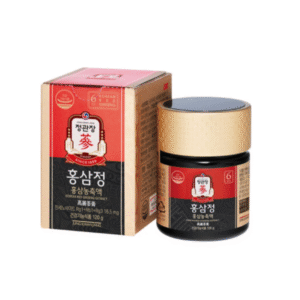Chronic inflammation is at the root of many modern health issues — from arthritis and muscle soreness to heart disease and fatigue. While conventional treatments often focus on managing symptoms, natural remedies like Korean Red Ginseng (Panax ginseng C.A. Meyer) target the underlying causes of inflammation.
For centuries, Korean Red Ginseng has been valued in traditional medicine as a powerful adaptogen that restores body balance, enhances resilience, and reduces pain. Modern science now confirms these ancient claims, showing that ginseng’s unique compounds — called ginsenosides — play a vital role in modulating inflammation and supporting recovery.
1. Understanding the Link Between Inflammation and Pain
Inflammation is the body’s natural defense against injury, infection, or stress. However, when inflammation becomes chronic, it can lead to persistent pain, stiffness, and tissue damage.
Conditions such as arthritis, fibromyalgia, muscle strain, and autoimmune disorders are all connected to chronic inflammation.
Korean Red Ginseng acts as a biological modulator, helping the immune system return to balance by:
- Reducing excess production of inflammatory cytokines (like TNF-α and IL-6)
- Enhancing antioxidant capacity
- Promoting tissue repair and microcirculation
👉 Reference: Frontiers in Pharmacology – Anti-Inflammatory Properties of Ginsenosides
2. Ginsenosides: Nature’s Anti-Inflammatory Molecules
The key to Korean Red Ginseng’s anti-inflammatory benefits lies in its ginsenosides, the plant’s active saponins. These compounds have been shown to inhibit NF-κB, a protein complex that triggers the body’s inflammatory response.
By blocking NF-κB activation, ginseng effectively reduces:
- Pain and swelling in joints
- Muscle inflammation after exercise
- Autoimmune tissue damage
- Oxidative stress linked to chronic disease
One study published in Biochemical Pharmacology found that ginsenoside Rg3 suppresses nitric oxide (NO) and prostaglandin E2 (PGE2) — both key mediators of pain and inflammation.
3. Relieving Arthritis and Joint Pain Naturally
Korean Red Ginseng is particularly effective for those suffering from osteoarthritis and rheumatoid arthritis. Clinical studies have reported:
- Reduced joint stiffness and swelling
- Improved mobility
- Decreased inflammatory markers (CRP, ESR)
In one Korean trial, patients taking red ginseng extract daily for 12 weeks experienced significant improvements in pain scores and joint flexibility compared to the placebo group.
Its natural anti-inflammatory mechanism makes it a gentle, long-term alternative to pain medications that may have side effects.
4. Muscle Recovery and Post-Exercise Inflammation
For athletes and active individuals, ginseng’s ability to accelerate muscle recovery is a major advantage. Intense physical activity causes microtears in muscles, leading to inflammation and soreness.
Korean Red Ginseng helps by:
- Reducing lactic acid buildup
- Lowering inflammatory cytokines after exercise
- Enhancing energy metabolism and oxygen delivery
A 2018 study in the Journal of Ginseng Research showed that athletes who supplemented with red ginseng for 8 weeks reported faster muscle recovery and less post-exercise pain, thanks to improved antioxidant defense and reduced inflammation.
5. Supporting Nerve and Chronic Pain Conditions
Beyond muscles and joints, inflammation can also affect the nervous system. Chronic inflammation contributes to neuropathic pain — a persistent, burning pain caused by nerve damage.
Korean Red Ginseng shows promise in modulating neuroinflammation and protecting nerve cells from oxidative damage. Ginsenosides like Rb1 and Rg1 help restore nerve function and reduce pain sensitivity by balancing neurotransmitter activity.
This neuroprotective effect makes it beneficial for people with conditions such as fibromyalgia, diabetic neuropathy, or nerve pain related to inflammation.
6. How to Take Korean Red Ginseng for Inflammation and Pain Relief
| Form | Recommended Use | Key Benefits |
|---|---|---|
| Extract or tonic | 1–2 teaspoons daily | Fast absorption, energy boost, inflammation control |
| Capsules or tablets | 300–1000 mg/day | Convenient for daily pain management |
| Powder | Mix into warm tea or smoothies | Sustained anti-inflammatory support |
| Topical cream or patch | Apply to affected areas | Local pain relief and improved circulation |
To enhance results, pair Korean Red Ginseng with an anti-inflammatory diet (rich in omega-3s, fruits, and vegetables) and regular movement such as yoga or light stretching.
7. Complementary Benefits for the Whole Body
Beyond pain relief, the anti-inflammatory properties of Korean Red Ginseng extend to the entire body. Studies show that regular supplementation can help:
- Support heart health by reducing arterial inflammation
- Protect lungs from inflammation caused by pollution or infection
- Improve gut health by regulating inflammatory gut bacteria
- Strengthen immune balance, preventing chronic disease progression
This holistic benefit reinforces its reputation as an adaptogenic herb that helps the body resist physical, chemical, and biological stressors.
8. Final Thoughts
Korean Red Ginseng offers a powerful, natural alternative for managing inflammation and chronic pain — backed by both tradition and modern science.
Its unique ginsenosides target the root causes of inflammation, support tissue repair, and help the body recover from stress and fatigue.
Whether you are dealing with joint stiffness, muscle soreness, or chronic inflammation, integrating Korean Red Ginseng into your daily routine can help you move more freely, recover faster, and live with greater vitality.
🇰🇷 Premium Korean Ginseng Online Shop







